Wind Catchers: Ventilation Systems in Modern Buildings - Essay
VerifiedAdded on 2020/05/28
|23
|7359
|52
Essay
AI Summary
This essay examines the application of wind catchers as ventilation systems in modern buildings. It emphasizes the importance of ventilation for indoor environments, particularly in public spaces, and highlights the drawbacks of traditional, energy-intensive mechanical systems. The essay contrasts these with the energy-efficient wind catcher systems (badgirs) used in regions like the Middle East, which utilize natural resources for ventilation. The primary objective is to investigate the features, advantages, potential, and disadvantages of wind catchers, while also assessing their suitability for contemporary buildings. The essay also aims to explore how to improve the efficiency and reliability of these natural ventilation systems. The need for alternative ventilation systems is underscored by rising global temperatures, climate change, and increasing energy demands. The essay delves into the environmental, economic, and social impacts of energy consumption, especially the burning of fossil fuels, and argues for the adoption of sustainable architectural designs like wind catchers to reduce energy consumption and carbon emissions. The essay provides a historical overview of wind catchers, their origins in Persian architecture, and their evolution and spread to other regions, describing their design, functionality, and potential benefits, while also acknowledging the need for improvements to enhance their performance in modern applications.

Wind Catchers as Ventilation Systems 1
APPLICATION OF WIND CATCHERS AS VENTILATION SYSTEMS IN MODERN
BUILDINGS
Name
Course
Professor
University
City/state
Date
APPLICATION OF WIND CATCHERS AS VENTILATION SYSTEMS IN MODERN
BUILDINGS
Name
Course
Professor
University
City/state
Date
Paraphrase This Document
Need a fresh take? Get an instant paraphrase of this document with our AI Paraphraser
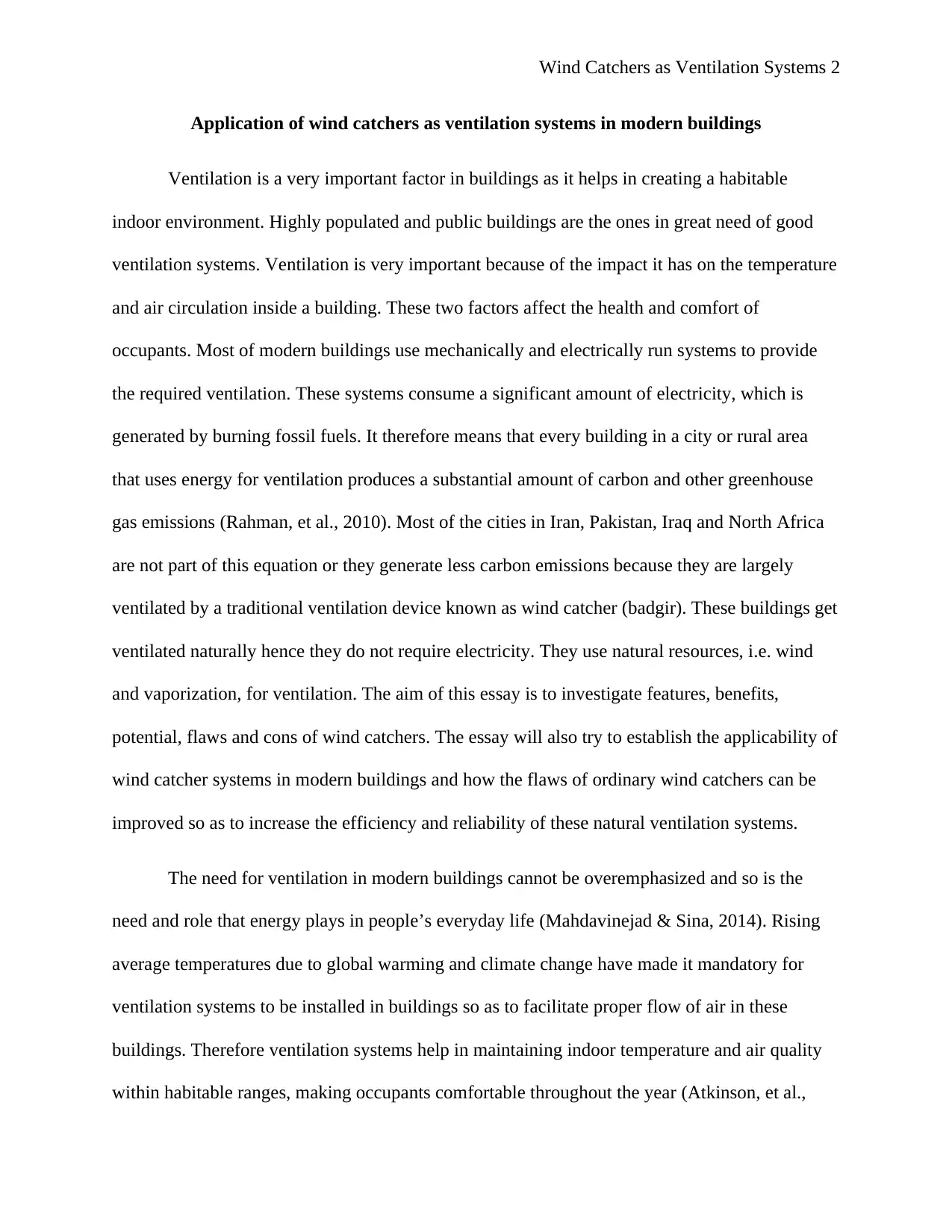
Wind Catchers as Ventilation Systems 2
Application of wind catchers as ventilation systems in modern buildings
Ventilation is a very important factor in buildings as it helps in creating a habitable
indoor environment. Highly populated and public buildings are the ones in great need of good
ventilation systems. Ventilation is very important because of the impact it has on the temperature
and air circulation inside a building. These two factors affect the health and comfort of
occupants. Most of modern buildings use mechanically and electrically run systems to provide
the required ventilation. These systems consume a significant amount of electricity, which is
generated by burning fossil fuels. It therefore means that every building in a city or rural area
that uses energy for ventilation produces a substantial amount of carbon and other greenhouse
gas emissions (Rahman, et al., 2010). Most of the cities in Iran, Pakistan, Iraq and North Africa
are not part of this equation or they generate less carbon emissions because they are largely
ventilated by a traditional ventilation device known as wind catcher (badgir). These buildings get
ventilated naturally hence they do not require electricity. They use natural resources, i.e. wind
and vaporization, for ventilation. The aim of this essay is to investigate features, benefits,
potential, flaws and cons of wind catchers. The essay will also try to establish the applicability of
wind catcher systems in modern buildings and how the flaws of ordinary wind catchers can be
improved so as to increase the efficiency and reliability of these natural ventilation systems.
The need for ventilation in modern buildings cannot be overemphasized and so is the
need and role that energy plays in people’s everyday life (Mahdavinejad & Sina, 2014). Rising
average temperatures due to global warming and climate change have made it mandatory for
ventilation systems to be installed in buildings so as to facilitate proper flow of air in these
buildings. Therefore ventilation systems help in maintaining indoor temperature and air quality
within habitable ranges, making occupants comfortable throughout the year (Atkinson, et al.,
Application of wind catchers as ventilation systems in modern buildings
Ventilation is a very important factor in buildings as it helps in creating a habitable
indoor environment. Highly populated and public buildings are the ones in great need of good
ventilation systems. Ventilation is very important because of the impact it has on the temperature
and air circulation inside a building. These two factors affect the health and comfort of
occupants. Most of modern buildings use mechanically and electrically run systems to provide
the required ventilation. These systems consume a significant amount of electricity, which is
generated by burning fossil fuels. It therefore means that every building in a city or rural area
that uses energy for ventilation produces a substantial amount of carbon and other greenhouse
gas emissions (Rahman, et al., 2010). Most of the cities in Iran, Pakistan, Iraq and North Africa
are not part of this equation or they generate less carbon emissions because they are largely
ventilated by a traditional ventilation device known as wind catcher (badgir). These buildings get
ventilated naturally hence they do not require electricity. They use natural resources, i.e. wind
and vaporization, for ventilation. The aim of this essay is to investigate features, benefits,
potential, flaws and cons of wind catchers. The essay will also try to establish the applicability of
wind catcher systems in modern buildings and how the flaws of ordinary wind catchers can be
improved so as to increase the efficiency and reliability of these natural ventilation systems.
The need for ventilation in modern buildings cannot be overemphasized and so is the
need and role that energy plays in people’s everyday life (Mahdavinejad & Sina, 2014). Rising
average temperatures due to global warming and climate change have made it mandatory for
ventilation systems to be installed in buildings so as to facilitate proper flow of air in these
buildings. Therefore ventilation systems help in maintaining indoor temperature and air quality
within habitable ranges, making occupants comfortable throughout the year (Atkinson, et al.,
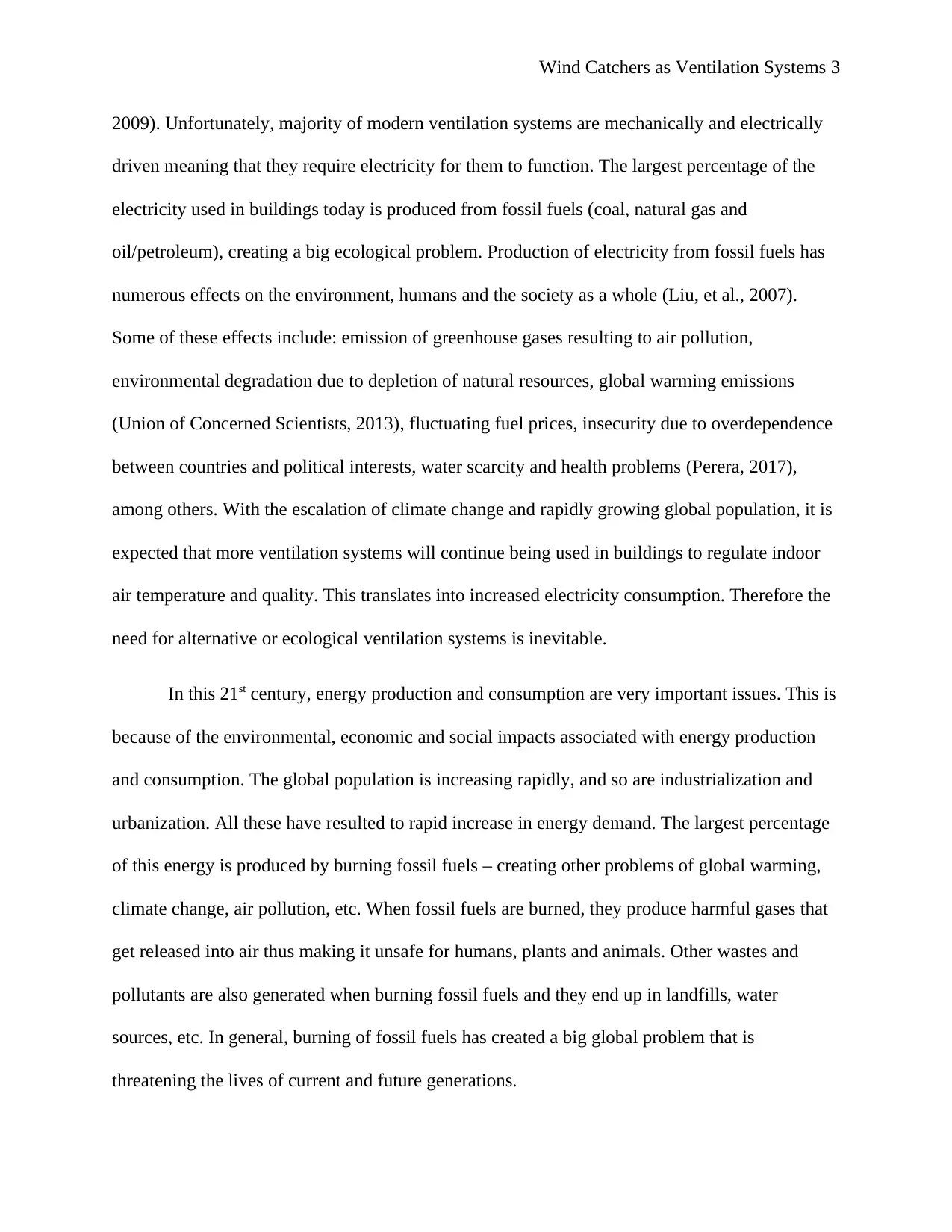
Wind Catchers as Ventilation Systems 3
2009). Unfortunately, majority of modern ventilation systems are mechanically and electrically
driven meaning that they require electricity for them to function. The largest percentage of the
electricity used in buildings today is produced from fossil fuels (coal, natural gas and
oil/petroleum), creating a big ecological problem. Production of electricity from fossil fuels has
numerous effects on the environment, humans and the society as a whole (Liu, et al., 2007).
Some of these effects include: emission of greenhouse gases resulting to air pollution,
environmental degradation due to depletion of natural resources, global warming emissions
(Union of Concerned Scientists, 2013), fluctuating fuel prices, insecurity due to overdependence
between countries and political interests, water scarcity and health problems (Perera, 2017),
among others. With the escalation of climate change and rapidly growing global population, it is
expected that more ventilation systems will continue being used in buildings to regulate indoor
air temperature and quality. This translates into increased electricity consumption. Therefore the
need for alternative or ecological ventilation systems is inevitable.
In this 21st century, energy production and consumption are very important issues. This is
because of the environmental, economic and social impacts associated with energy production
and consumption. The global population is increasing rapidly, and so are industrialization and
urbanization. All these have resulted to rapid increase in energy demand. The largest percentage
of this energy is produced by burning fossil fuels – creating other problems of global warming,
climate change, air pollution, etc. When fossil fuels are burned, they produce harmful gases that
get released into air thus making it unsafe for humans, plants and animals. Other wastes and
pollutants are also generated when burning fossil fuels and they end up in landfills, water
sources, etc. In general, burning of fossil fuels has created a big global problem that is
threatening the lives of current and future generations.
2009). Unfortunately, majority of modern ventilation systems are mechanically and electrically
driven meaning that they require electricity for them to function. The largest percentage of the
electricity used in buildings today is produced from fossil fuels (coal, natural gas and
oil/petroleum), creating a big ecological problem. Production of electricity from fossil fuels has
numerous effects on the environment, humans and the society as a whole (Liu, et al., 2007).
Some of these effects include: emission of greenhouse gases resulting to air pollution,
environmental degradation due to depletion of natural resources, global warming emissions
(Union of Concerned Scientists, 2013), fluctuating fuel prices, insecurity due to overdependence
between countries and political interests, water scarcity and health problems (Perera, 2017),
among others. With the escalation of climate change and rapidly growing global population, it is
expected that more ventilation systems will continue being used in buildings to regulate indoor
air temperature and quality. This translates into increased electricity consumption. Therefore the
need for alternative or ecological ventilation systems is inevitable.
In this 21st century, energy production and consumption are very important issues. This is
because of the environmental, economic and social impacts associated with energy production
and consumption. The global population is increasing rapidly, and so are industrialization and
urbanization. All these have resulted to rapid increase in energy demand. The largest percentage
of this energy is produced by burning fossil fuels – creating other problems of global warming,
climate change, air pollution, etc. When fossil fuels are burned, they produce harmful gases that
get released into air thus making it unsafe for humans, plants and animals. Other wastes and
pollutants are also generated when burning fossil fuels and they end up in landfills, water
sources, etc. In general, burning of fossil fuels has created a big global problem that is
threatening the lives of current and future generations.
⊘ This is a preview!⊘
Do you want full access?
Subscribe today to unlock all pages.

Trusted by 1+ million students worldwide
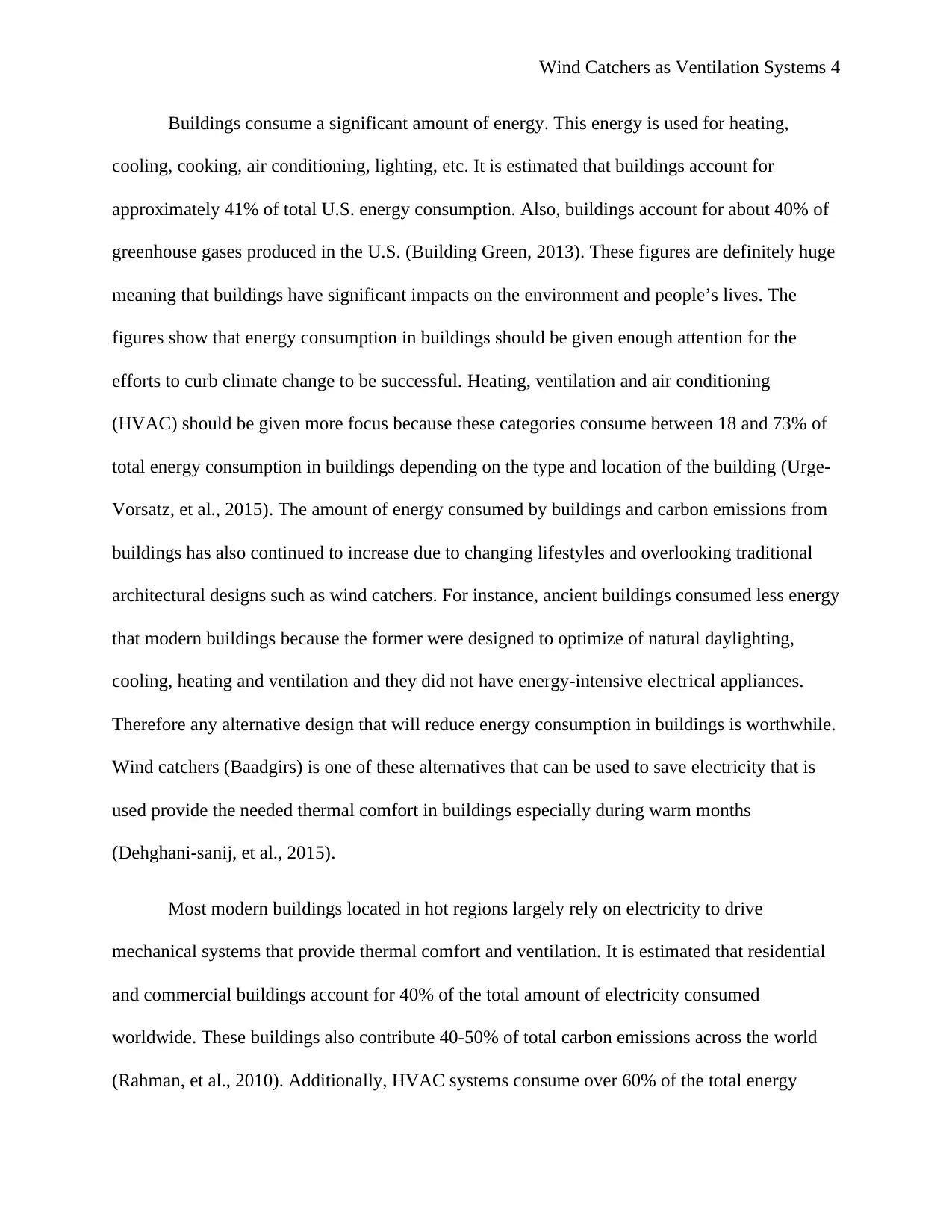
Wind Catchers as Ventilation Systems 4
Buildings consume a significant amount of energy. This energy is used for heating,
cooling, cooking, air conditioning, lighting, etc. It is estimated that buildings account for
approximately 41% of total U.S. energy consumption. Also, buildings account for about 40% of
greenhouse gases produced in the U.S. (Building Green, 2013). These figures are definitely huge
meaning that buildings have significant impacts on the environment and people’s lives. The
figures show that energy consumption in buildings should be given enough attention for the
efforts to curb climate change to be successful. Heating, ventilation and air conditioning
(HVAC) should be given more focus because these categories consume between 18 and 73% of
total energy consumption in buildings depending on the type and location of the building (Urge-
Vorsatz, et al., 2015). The amount of energy consumed by buildings and carbon emissions from
buildings has also continued to increase due to changing lifestyles and overlooking traditional
architectural designs such as wind catchers. For instance, ancient buildings consumed less energy
that modern buildings because the former were designed to optimize of natural daylighting,
cooling, heating and ventilation and they did not have energy-intensive electrical appliances.
Therefore any alternative design that will reduce energy consumption in buildings is worthwhile.
Wind catchers (Baadgirs) is one of these alternatives that can be used to save electricity that is
used provide the needed thermal comfort in buildings especially during warm months
(Dehghani-sanij, et al., 2015).
Most modern buildings located in hot regions largely rely on electricity to drive
mechanical systems that provide thermal comfort and ventilation. It is estimated that residential
and commercial buildings account for 40% of the total amount of electricity consumed
worldwide. These buildings also contribute 40-50% of total carbon emissions across the world
(Rahman, et al., 2010). Additionally, HVAC systems consume over 60% of the total energy
Buildings consume a significant amount of energy. This energy is used for heating,
cooling, cooking, air conditioning, lighting, etc. It is estimated that buildings account for
approximately 41% of total U.S. energy consumption. Also, buildings account for about 40% of
greenhouse gases produced in the U.S. (Building Green, 2013). These figures are definitely huge
meaning that buildings have significant impacts on the environment and people’s lives. The
figures show that energy consumption in buildings should be given enough attention for the
efforts to curb climate change to be successful. Heating, ventilation and air conditioning
(HVAC) should be given more focus because these categories consume between 18 and 73% of
total energy consumption in buildings depending on the type and location of the building (Urge-
Vorsatz, et al., 2015). The amount of energy consumed by buildings and carbon emissions from
buildings has also continued to increase due to changing lifestyles and overlooking traditional
architectural designs such as wind catchers. For instance, ancient buildings consumed less energy
that modern buildings because the former were designed to optimize of natural daylighting,
cooling, heating and ventilation and they did not have energy-intensive electrical appliances.
Therefore any alternative design that will reduce energy consumption in buildings is worthwhile.
Wind catchers (Baadgirs) is one of these alternatives that can be used to save electricity that is
used provide the needed thermal comfort in buildings especially during warm months
(Dehghani-sanij, et al., 2015).
Most modern buildings located in hot regions largely rely on electricity to drive
mechanical systems that provide thermal comfort and ventilation. It is estimated that residential
and commercial buildings account for 40% of the total amount of electricity consumed
worldwide. These buildings also contribute 40-50% of total carbon emissions across the world
(Rahman, et al., 2010). Additionally, HVAC systems consume over 60% of the total energy
Paraphrase This Document
Need a fresh take? Get an instant paraphrase of this document with our AI Paraphraser

Wind Catchers as Ventilation Systems 5
consumed in buildings (Yau & Lee, 2010). With this information, it is apparent that there is great
opportunity of lowering energy consumption in buildings and greenhouse gas emissions. As a
matter of fact, global warming has become one of the most life-threatening problems in the
world (Jomehzadeh, et al., 2017). People have to work together so as to solve this problem. One
of the ways of achieving this is for people to acceptable traditional architectural systems, and
relevant stakeholders should be in the forefront to lean this mission.
Architects, engineers and building designers have a big role to play in reducing
greenhouse gas emissions. There are various ways of achieving this including adoption of green
building practices. The basic principles of these practices are to increase resource efficiency and
reduce greenhouse gas emissions throughout the lifecycle of buildings without compromising the
functionality and comfort of the buildings. Architectural designs such as wind catchers can
significantly lower carbon emissions by simplify reducing energy demand for buildings.
Wind catchers (Badgir) are traditional ventilation systems that have the potential of
playing an essential role in reducing energy consumption and related emissions in buildings
(Bahadori, et al., 2014). These systems create natural ventilation inside buildings (Ahmadikia, et
al., 2012). It is believed that wind catchers originated from Iran even though the person who
invented it remains unknown. Previously, wind catchers were very common in the Middle East
countries, especially Pakistan, Afghanistan and Iran (Calautit & Hughes, 2015). Temperatures in
these countries are usually high throughout the year and wind catchers were used to cool down
buildings so as to make them habitable (Wogan, 2011). The devices were widely used in Yazd,
Iran (Zareie & Izadpanah, 2015) and some buildings in the city still have the ancient wind
catchers (Hedayat, et al., 2017). Years later, the use of wind catchers spread to other arid and
semi-arid countries such as Egypt, Asian countries, Iraq, Syria and Jordan.
consumed in buildings (Yau & Lee, 2010). With this information, it is apparent that there is great
opportunity of lowering energy consumption in buildings and greenhouse gas emissions. As a
matter of fact, global warming has become one of the most life-threatening problems in the
world (Jomehzadeh, et al., 2017). People have to work together so as to solve this problem. One
of the ways of achieving this is for people to acceptable traditional architectural systems, and
relevant stakeholders should be in the forefront to lean this mission.
Architects, engineers and building designers have a big role to play in reducing
greenhouse gas emissions. There are various ways of achieving this including adoption of green
building practices. The basic principles of these practices are to increase resource efficiency and
reduce greenhouse gas emissions throughout the lifecycle of buildings without compromising the
functionality and comfort of the buildings. Architectural designs such as wind catchers can
significantly lower carbon emissions by simplify reducing energy demand for buildings.
Wind catchers (Badgir) are traditional ventilation systems that have the potential of
playing an essential role in reducing energy consumption and related emissions in buildings
(Bahadori, et al., 2014). These systems create natural ventilation inside buildings (Ahmadikia, et
al., 2012). It is believed that wind catchers originated from Iran even though the person who
invented it remains unknown. Previously, wind catchers were very common in the Middle East
countries, especially Pakistan, Afghanistan and Iran (Calautit & Hughes, 2015). Temperatures in
these countries are usually high throughout the year and wind catchers were used to cool down
buildings so as to make them habitable (Wogan, 2011). The devices were widely used in Yazd,
Iran (Zareie & Izadpanah, 2015) and some buildings in the city still have the ancient wind
catchers (Hedayat, et al., 2017). Years later, the use of wind catchers spread to other arid and
semi-arid countries such as Egypt, Asian countries, Iraq, Syria and Jordan.

Wind Catchers as Ventilation Systems 6
A wind catcher is a traditional architectural design device that was based on Persian
architecture. Originally, this architectural design was used in building traditional water
reservoirs. The reservoirs were built with wind catchers, which were able to store water close to
freezing temperature especially in summer months. Later, this architectural principle was used to
create wind catchers, which were used for creating natural ventilation inside buildings.
Development of this traditional architectural device was driven by people’s culture, local climate
and traditions (El-Shorbagy, 2010). The design of wind catchers was mainly influenced by the
environment and human needs. These devices were very common in cities such as Yazd, Bam,
Nain, Kashan, Kerman and Sirjan, among others.
The popularity and use of wind catchers started increasing during 1970s’ energy crisis.
The crisis led to development of sustainable or ecological architectural systems that would
reduce energy consumption in buildings. One of these systems was wind catchers (Zarandi,
2009). After proving to be effective in regulating indoor temperature, use of wind catchers
spread to different parts of the world. Wind catcher is known as badgir in Gulf area and Iran.
This is a multi-directional wind catcher containing openings at the top in all sides. These
openings enable the wind catcher to collect wind from all directions. The original wind catcher
had only one opening facing the direction of the wind. Modern wind catchers are designed such
that they can draw air from any direction (Calautit & Hughes, 2014).
The suitability of the type of wind catcher to be used is mainly determined by airflow
direction at that particular location. For instance, if the wind tends to flow from one direction
only then a unidirectional wind catcher having only one opening facing the direction where the
wind is flowing from will be appropriate for a building in that particular area. At first, most wind
catchers were built to face away from the wind so as to prevent unwanted materials such as sand,
A wind catcher is a traditional architectural design device that was based on Persian
architecture. Originally, this architectural design was used in building traditional water
reservoirs. The reservoirs were built with wind catchers, which were able to store water close to
freezing temperature especially in summer months. Later, this architectural principle was used to
create wind catchers, which were used for creating natural ventilation inside buildings.
Development of this traditional architectural device was driven by people’s culture, local climate
and traditions (El-Shorbagy, 2010). The design of wind catchers was mainly influenced by the
environment and human needs. These devices were very common in cities such as Yazd, Bam,
Nain, Kashan, Kerman and Sirjan, among others.
The popularity and use of wind catchers started increasing during 1970s’ energy crisis.
The crisis led to development of sustainable or ecological architectural systems that would
reduce energy consumption in buildings. One of these systems was wind catchers (Zarandi,
2009). After proving to be effective in regulating indoor temperature, use of wind catchers
spread to different parts of the world. Wind catcher is known as badgir in Gulf area and Iran.
This is a multi-directional wind catcher containing openings at the top in all sides. These
openings enable the wind catcher to collect wind from all directions. The original wind catcher
had only one opening facing the direction of the wind. Modern wind catchers are designed such
that they can draw air from any direction (Calautit & Hughes, 2014).
The suitability of the type of wind catcher to be used is mainly determined by airflow
direction at that particular location. For instance, if the wind tends to flow from one direction
only then a unidirectional wind catcher having only one opening facing the direction where the
wind is flowing from will be appropriate for a building in that particular area. At first, most wind
catchers were built to face away from the wind so as to prevent unwanted materials such as sand,
⊘ This is a preview!⊘
Do you want full access?
Subscribe today to unlock all pages.

Trusted by 1+ million students worldwide

Wind Catchers as Ventilation Systems 7
dust and insects from entering the building. This changed later as the wind catchers were
designed and installed with other devices to prevent entry of unwanted materials.
Wind catcher is a device that creates natural ventilation in buildings. Some studies have
shown that the ventilation provided by wind catchers is even better than that of openable
windows (Elmualim, 2016). The device is usually at the topmost part of the building and that is
why it is also called wind tower. This device catches or captures cooler prevailing breeze or wind
and direct it into the building (Alsuliman, 2014). The wind catcher has a cap at the top and at
least two directional openings on its sides. Traditional wind catchers usually had two openings.
One of the openings was positioned to face the windward side and its function was to capture
cool air and direct it into the building. The other opening was positioned to face the leeward side
and its function was to evacuate hot air from the building by suction. When openings on the
leeward side are opened, air gets sucked upwards by Coanda effect. This air s then discharged
into the atmosphere. When the openings on the windward side are opened, air gets drawn
downwards into the building. The air from the outside is usually cool and therefore it lowers
indoor temperature when it gets drawn into the building through the wind catcher.
There are three different ways in which a wind catcher can function. The first is where
airflow is directed downwards by direct wind entry. This is the most common design of wind
catchers. Here the capped wind catcher has one opening (or a set of openings) facing the
windward side. This opening “catches” the cool, moving air and directs it downwards thus
maintaining airflow. The cool air creates a cooling effect inside the building thus lowering
indoor temperature. The second is where airflow is directed upwards by temperature gradient
assisted by wind. Here, one opening of the wind catcher (or a set of openings) faces the wind
ward side whereas the other opening (or set of openings) faces the leeward side. When the
dust and insects from entering the building. This changed later as the wind catchers were
designed and installed with other devices to prevent entry of unwanted materials.
Wind catcher is a device that creates natural ventilation in buildings. Some studies have
shown that the ventilation provided by wind catchers is even better than that of openable
windows (Elmualim, 2016). The device is usually at the topmost part of the building and that is
why it is also called wind tower. This device catches or captures cooler prevailing breeze or wind
and direct it into the building (Alsuliman, 2014). The wind catcher has a cap at the top and at
least two directional openings on its sides. Traditional wind catchers usually had two openings.
One of the openings was positioned to face the windward side and its function was to capture
cool air and direct it into the building. The other opening was positioned to face the leeward side
and its function was to evacuate hot air from the building by suction. When openings on the
leeward side are opened, air gets sucked upwards by Coanda effect. This air s then discharged
into the atmosphere. When the openings on the windward side are opened, air gets drawn
downwards into the building. The air from the outside is usually cool and therefore it lowers
indoor temperature when it gets drawn into the building through the wind catcher.
There are three different ways in which a wind catcher can function. The first is where
airflow is directed downwards by direct wind entry. This is the most common design of wind
catchers. Here the capped wind catcher has one opening (or a set of openings) facing the
windward side. This opening “catches” the cool, moving air and directs it downwards thus
maintaining airflow. The cool air creates a cooling effect inside the building thus lowering
indoor temperature. The second is where airflow is directed upwards by temperature gradient
assisted by wind. Here, one opening of the wind catcher (or a set of openings) faces the wind
ward side whereas the other opening (or set of openings) faces the leeward side. When the
Paraphrase This Document
Need a fresh take? Get an instant paraphrase of this document with our AI Paraphraser
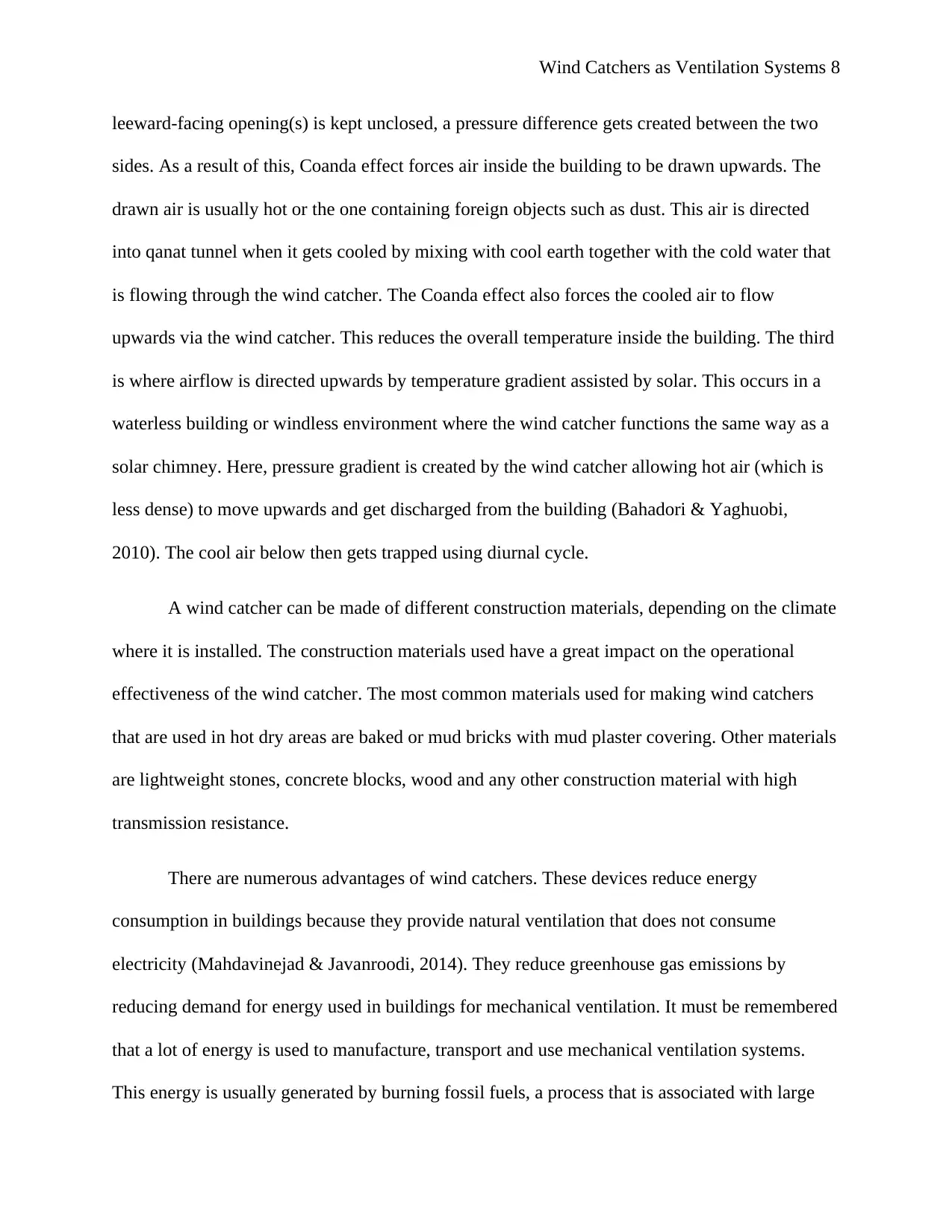
Wind Catchers as Ventilation Systems 8
leeward-facing opening(s) is kept unclosed, a pressure difference gets created between the two
sides. As a result of this, Coanda effect forces air inside the building to be drawn upwards. The
drawn air is usually hot or the one containing foreign objects such as dust. This air is directed
into qanat tunnel when it gets cooled by mixing with cool earth together with the cold water that
is flowing through the wind catcher. The Coanda effect also forces the cooled air to flow
upwards via the wind catcher. This reduces the overall temperature inside the building. The third
is where airflow is directed upwards by temperature gradient assisted by solar. This occurs in a
waterless building or windless environment where the wind catcher functions the same way as a
solar chimney. Here, pressure gradient is created by the wind catcher allowing hot air (which is
less dense) to move upwards and get discharged from the building (Bahadori & Yaghuobi,
2010). The cool air below then gets trapped using diurnal cycle.
A wind catcher can be made of different construction materials, depending on the climate
where it is installed. The construction materials used have a great impact on the operational
effectiveness of the wind catcher. The most common materials used for making wind catchers
that are used in hot dry areas are baked or mud bricks with mud plaster covering. Other materials
are lightweight stones, concrete blocks, wood and any other construction material with high
transmission resistance.
There are numerous advantages of wind catchers. These devices reduce energy
consumption in buildings because they provide natural ventilation that does not consume
electricity (Mahdavinejad & Javanroodi, 2014). They reduce greenhouse gas emissions by
reducing demand for energy used in buildings for mechanical ventilation. It must be remembered
that a lot of energy is used to manufacture, transport and use mechanical ventilation systems.
This energy is usually generated by burning fossil fuels, a process that is associated with large
leeward-facing opening(s) is kept unclosed, a pressure difference gets created between the two
sides. As a result of this, Coanda effect forces air inside the building to be drawn upwards. The
drawn air is usually hot or the one containing foreign objects such as dust. This air is directed
into qanat tunnel when it gets cooled by mixing with cool earth together with the cold water that
is flowing through the wind catcher. The Coanda effect also forces the cooled air to flow
upwards via the wind catcher. This reduces the overall temperature inside the building. The third
is where airflow is directed upwards by temperature gradient assisted by solar. This occurs in a
waterless building or windless environment where the wind catcher functions the same way as a
solar chimney. Here, pressure gradient is created by the wind catcher allowing hot air (which is
less dense) to move upwards and get discharged from the building (Bahadori & Yaghuobi,
2010). The cool air below then gets trapped using diurnal cycle.
A wind catcher can be made of different construction materials, depending on the climate
where it is installed. The construction materials used have a great impact on the operational
effectiveness of the wind catcher. The most common materials used for making wind catchers
that are used in hot dry areas are baked or mud bricks with mud plaster covering. Other materials
are lightweight stones, concrete blocks, wood and any other construction material with high
transmission resistance.
There are numerous advantages of wind catchers. These devices reduce energy
consumption in buildings because they provide natural ventilation that does not consume
electricity (Mahdavinejad & Javanroodi, 2014). They reduce greenhouse gas emissions by
reducing demand for energy used in buildings for mechanical ventilation. It must be remembered
that a lot of energy is used to manufacture, transport and use mechanical ventilation systems.
This energy is usually generated by burning fossil fuels, a process that is associated with large
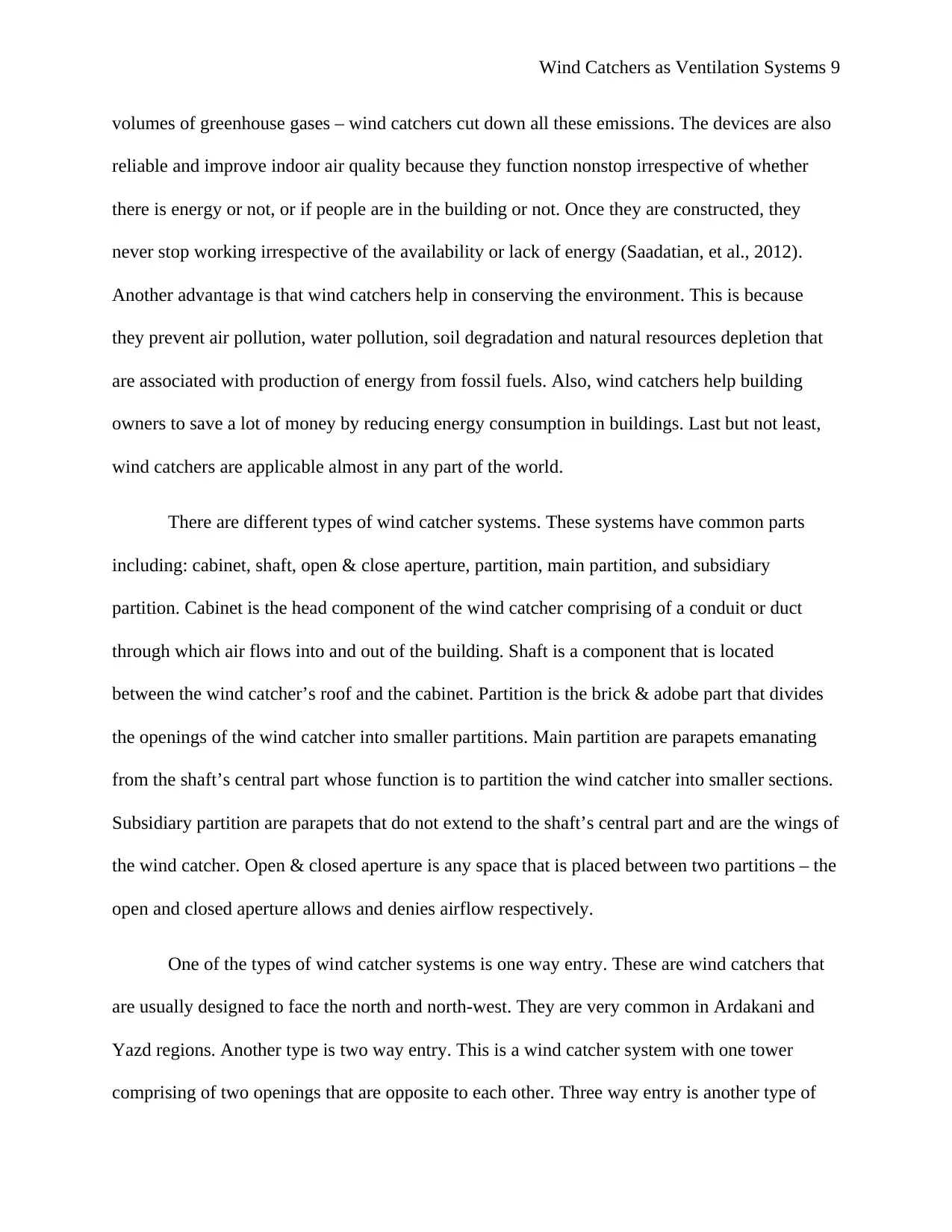
Wind Catchers as Ventilation Systems 9
volumes of greenhouse gases – wind catchers cut down all these emissions. The devices are also
reliable and improve indoor air quality because they function nonstop irrespective of whether
there is energy or not, or if people are in the building or not. Once they are constructed, they
never stop working irrespective of the availability or lack of energy (Saadatian, et al., 2012).
Another advantage is that wind catchers help in conserving the environment. This is because
they prevent air pollution, water pollution, soil degradation and natural resources depletion that
are associated with production of energy from fossil fuels. Also, wind catchers help building
owners to save a lot of money by reducing energy consumption in buildings. Last but not least,
wind catchers are applicable almost in any part of the world.
There are different types of wind catcher systems. These systems have common parts
including: cabinet, shaft, open & close aperture, partition, main partition, and subsidiary
partition. Cabinet is the head component of the wind catcher comprising of a conduit or duct
through which air flows into and out of the building. Shaft is a component that is located
between the wind catcher’s roof and the cabinet. Partition is the brick & adobe part that divides
the openings of the wind catcher into smaller partitions. Main partition are parapets emanating
from the shaft’s central part whose function is to partition the wind catcher into smaller sections.
Subsidiary partition are parapets that do not extend to the shaft’s central part and are the wings of
the wind catcher. Open & closed aperture is any space that is placed between two partitions – the
open and closed aperture allows and denies airflow respectively.
One of the types of wind catcher systems is one way entry. These are wind catchers that
are usually designed to face the north and north-west. They are very common in Ardakani and
Yazd regions. Another type is two way entry. This is a wind catcher system with one tower
comprising of two openings that are opposite to each other. Three way entry is another type of
volumes of greenhouse gases – wind catchers cut down all these emissions. The devices are also
reliable and improve indoor air quality because they function nonstop irrespective of whether
there is energy or not, or if people are in the building or not. Once they are constructed, they
never stop working irrespective of the availability or lack of energy (Saadatian, et al., 2012).
Another advantage is that wind catchers help in conserving the environment. This is because
they prevent air pollution, water pollution, soil degradation and natural resources depletion that
are associated with production of energy from fossil fuels. Also, wind catchers help building
owners to save a lot of money by reducing energy consumption in buildings. Last but not least,
wind catchers are applicable almost in any part of the world.
There are different types of wind catcher systems. These systems have common parts
including: cabinet, shaft, open & close aperture, partition, main partition, and subsidiary
partition. Cabinet is the head component of the wind catcher comprising of a conduit or duct
through which air flows into and out of the building. Shaft is a component that is located
between the wind catcher’s roof and the cabinet. Partition is the brick & adobe part that divides
the openings of the wind catcher into smaller partitions. Main partition are parapets emanating
from the shaft’s central part whose function is to partition the wind catcher into smaller sections.
Subsidiary partition are parapets that do not extend to the shaft’s central part and are the wings of
the wind catcher. Open & closed aperture is any space that is placed between two partitions – the
open and closed aperture allows and denies airflow respectively.
One of the types of wind catcher systems is one way entry. These are wind catchers that
are usually designed to face the north and north-west. They are very common in Ardakani and
Yazd regions. Another type is two way entry. This is a wind catcher system with one tower
comprising of two openings that are opposite to each other. Three way entry is another type of
⊘ This is a preview!⊘
Do you want full access?
Subscribe today to unlock all pages.

Trusted by 1+ million students worldwide
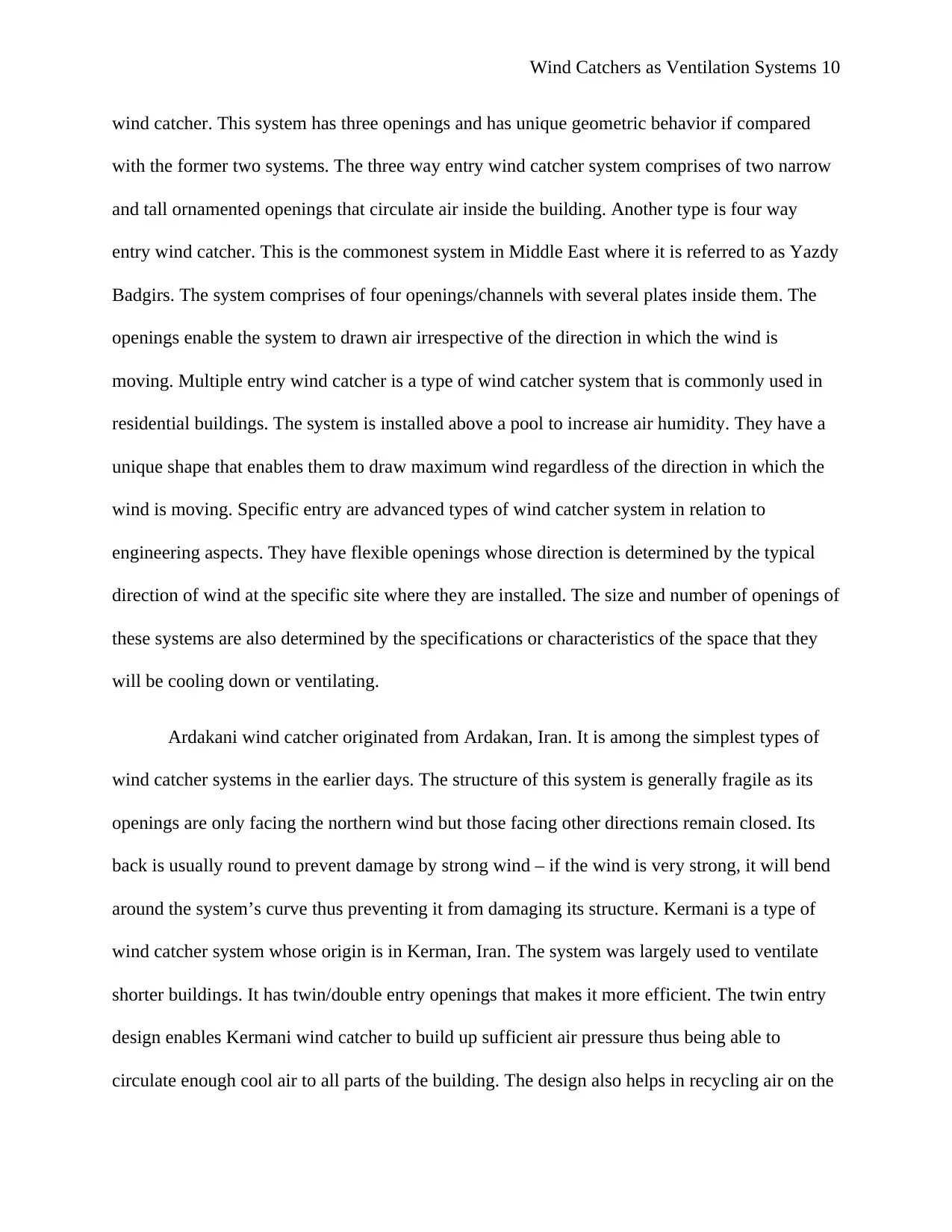
Wind Catchers as Ventilation Systems 10
wind catcher. This system has three openings and has unique geometric behavior if compared
with the former two systems. The three way entry wind catcher system comprises of two narrow
and tall ornamented openings that circulate air inside the building. Another type is four way
entry wind catcher. This is the commonest system in Middle East where it is referred to as Yazdy
Badgirs. The system comprises of four openings/channels with several plates inside them. The
openings enable the system to drawn air irrespective of the direction in which the wind is
moving. Multiple entry wind catcher is a type of wind catcher system that is commonly used in
residential buildings. The system is installed above a pool to increase air humidity. They have a
unique shape that enables them to draw maximum wind regardless of the direction in which the
wind is moving. Specific entry are advanced types of wind catcher system in relation to
engineering aspects. They have flexible openings whose direction is determined by the typical
direction of wind at the specific site where they are installed. The size and number of openings of
these systems are also determined by the specifications or characteristics of the space that they
will be cooling down or ventilating.
Ardakani wind catcher originated from Ardakan, Iran. It is among the simplest types of
wind catcher systems in the earlier days. The structure of this system is generally fragile as its
openings are only facing the northern wind but those facing other directions remain closed. Its
back is usually round to prevent damage by strong wind – if the wind is very strong, it will bend
around the system’s curve thus preventing it from damaging its structure. Kermani is a type of
wind catcher system whose origin is in Kerman, Iran. The system was largely used to ventilate
shorter buildings. It has twin/double entry openings that makes it more efficient. The twin entry
design enables Kermani wind catcher to build up sufficient air pressure thus being able to
circulate enough cool air to all parts of the building. The design also helps in recycling air on the
wind catcher. This system has three openings and has unique geometric behavior if compared
with the former two systems. The three way entry wind catcher system comprises of two narrow
and tall ornamented openings that circulate air inside the building. Another type is four way
entry wind catcher. This is the commonest system in Middle East where it is referred to as Yazdy
Badgirs. The system comprises of four openings/channels with several plates inside them. The
openings enable the system to drawn air irrespective of the direction in which the wind is
moving. Multiple entry wind catcher is a type of wind catcher system that is commonly used in
residential buildings. The system is installed above a pool to increase air humidity. They have a
unique shape that enables them to draw maximum wind regardless of the direction in which the
wind is moving. Specific entry are advanced types of wind catcher system in relation to
engineering aspects. They have flexible openings whose direction is determined by the typical
direction of wind at the specific site where they are installed. The size and number of openings of
these systems are also determined by the specifications or characteristics of the space that they
will be cooling down or ventilating.
Ardakani wind catcher originated from Ardakan, Iran. It is among the simplest types of
wind catcher systems in the earlier days. The structure of this system is generally fragile as its
openings are only facing the northern wind but those facing other directions remain closed. Its
back is usually round to prevent damage by strong wind – if the wind is very strong, it will bend
around the system’s curve thus preventing it from damaging its structure. Kermani is a type of
wind catcher system whose origin is in Kerman, Iran. The system was largely used to ventilate
shorter buildings. It has twin/double entry openings that makes it more efficient. The twin entry
design enables Kermani wind catcher to build up sufficient air pressure thus being able to
circulate enough cool air to all parts of the building. The design also helps in recycling air on the
Paraphrase This Document
Need a fresh take? Get an instant paraphrase of this document with our AI Paraphraser
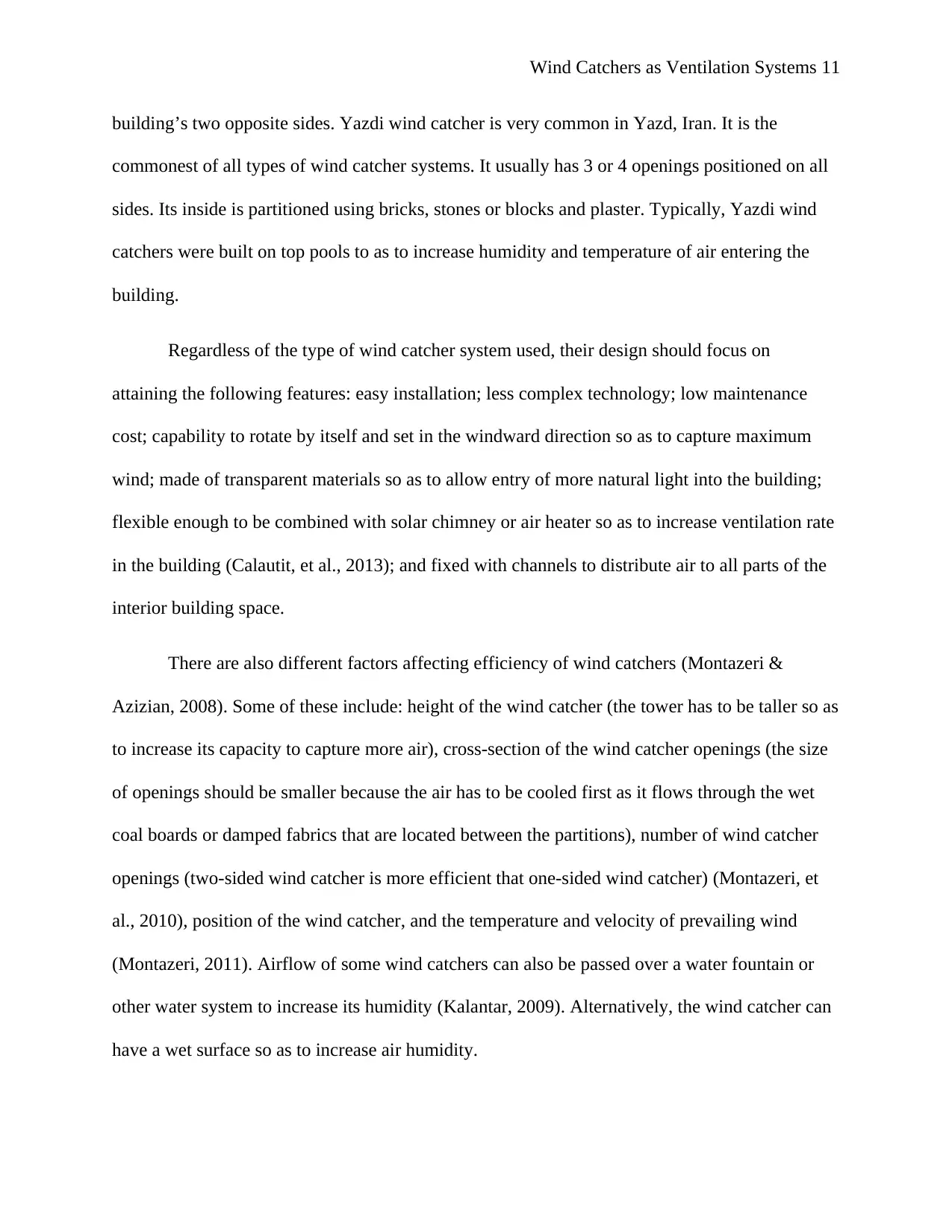
Wind Catchers as Ventilation Systems 11
building’s two opposite sides. Yazdi wind catcher is very common in Yazd, Iran. It is the
commonest of all types of wind catcher systems. It usually has 3 or 4 openings positioned on all
sides. Its inside is partitioned using bricks, stones or blocks and plaster. Typically, Yazdi wind
catchers were built on top pools to as to increase humidity and temperature of air entering the
building.
Regardless of the type of wind catcher system used, their design should focus on
attaining the following features: easy installation; less complex technology; low maintenance
cost; capability to rotate by itself and set in the windward direction so as to capture maximum
wind; made of transparent materials so as to allow entry of more natural light into the building;
flexible enough to be combined with solar chimney or air heater so as to increase ventilation rate
in the building (Calautit, et al., 2013); and fixed with channels to distribute air to all parts of the
interior building space.
There are also different factors affecting efficiency of wind catchers (Montazeri &
Azizian, 2008). Some of these include: height of the wind catcher (the tower has to be taller so as
to increase its capacity to capture more air), cross-section of the wind catcher openings (the size
of openings should be smaller because the air has to be cooled first as it flows through the wet
coal boards or damped fabrics that are located between the partitions), number of wind catcher
openings (two-sided wind catcher is more efficient that one-sided wind catcher) (Montazeri, et
al., 2010), position of the wind catcher, and the temperature and velocity of prevailing wind
(Montazeri, 2011). Airflow of some wind catchers can also be passed over a water fountain or
other water system to increase its humidity (Kalantar, 2009). Alternatively, the wind catcher can
have a wet surface so as to increase air humidity.
building’s two opposite sides. Yazdi wind catcher is very common in Yazd, Iran. It is the
commonest of all types of wind catcher systems. It usually has 3 or 4 openings positioned on all
sides. Its inside is partitioned using bricks, stones or blocks and plaster. Typically, Yazdi wind
catchers were built on top pools to as to increase humidity and temperature of air entering the
building.
Regardless of the type of wind catcher system used, their design should focus on
attaining the following features: easy installation; less complex technology; low maintenance
cost; capability to rotate by itself and set in the windward direction so as to capture maximum
wind; made of transparent materials so as to allow entry of more natural light into the building;
flexible enough to be combined with solar chimney or air heater so as to increase ventilation rate
in the building (Calautit, et al., 2013); and fixed with channels to distribute air to all parts of the
interior building space.
There are also different factors affecting efficiency of wind catchers (Montazeri &
Azizian, 2008). Some of these include: height of the wind catcher (the tower has to be taller so as
to increase its capacity to capture more air), cross-section of the wind catcher openings (the size
of openings should be smaller because the air has to be cooled first as it flows through the wet
coal boards or damped fabrics that are located between the partitions), number of wind catcher
openings (two-sided wind catcher is more efficient that one-sided wind catcher) (Montazeri, et
al., 2010), position of the wind catcher, and the temperature and velocity of prevailing wind
(Montazeri, 2011). Airflow of some wind catchers can also be passed over a water fountain or
other water system to increase its humidity (Kalantar, 2009). Alternatively, the wind catcher can
have a wet surface so as to increase air humidity.
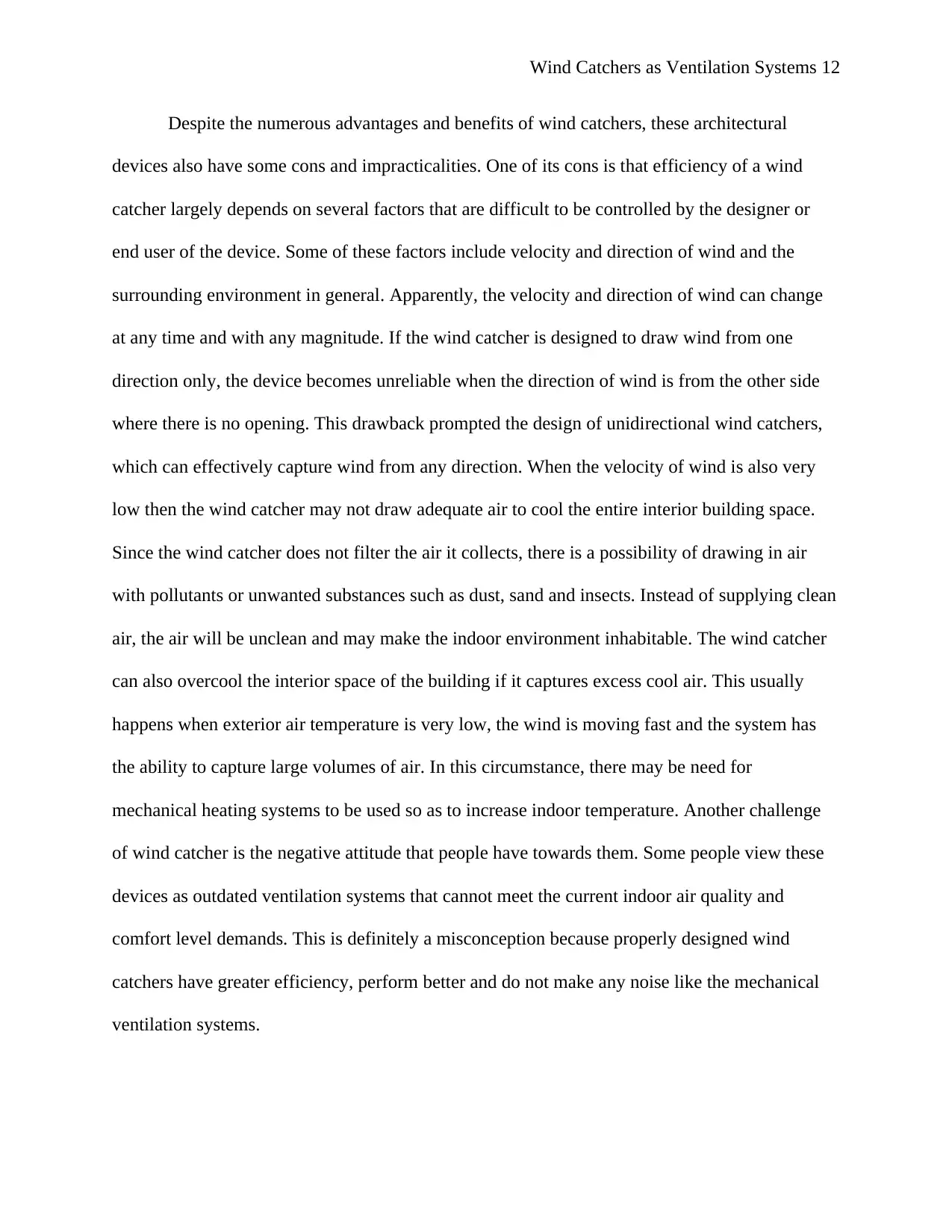
Wind Catchers as Ventilation Systems 12
Despite the numerous advantages and benefits of wind catchers, these architectural
devices also have some cons and impracticalities. One of its cons is that efficiency of a wind
catcher largely depends on several factors that are difficult to be controlled by the designer or
end user of the device. Some of these factors include velocity and direction of wind and the
surrounding environment in general. Apparently, the velocity and direction of wind can change
at any time and with any magnitude. If the wind catcher is designed to draw wind from one
direction only, the device becomes unreliable when the direction of wind is from the other side
where there is no opening. This drawback prompted the design of unidirectional wind catchers,
which can effectively capture wind from any direction. When the velocity of wind is also very
low then the wind catcher may not draw adequate air to cool the entire interior building space.
Since the wind catcher does not filter the air it collects, there is a possibility of drawing in air
with pollutants or unwanted substances such as dust, sand and insects. Instead of supplying clean
air, the air will be unclean and may make the indoor environment inhabitable. The wind catcher
can also overcool the interior space of the building if it captures excess cool air. This usually
happens when exterior air temperature is very low, the wind is moving fast and the system has
the ability to capture large volumes of air. In this circumstance, there may be need for
mechanical heating systems to be used so as to increase indoor temperature. Another challenge
of wind catcher is the negative attitude that people have towards them. Some people view these
devices as outdated ventilation systems that cannot meet the current indoor air quality and
comfort level demands. This is definitely a misconception because properly designed wind
catchers have greater efficiency, perform better and do not make any noise like the mechanical
ventilation systems.
Despite the numerous advantages and benefits of wind catchers, these architectural
devices also have some cons and impracticalities. One of its cons is that efficiency of a wind
catcher largely depends on several factors that are difficult to be controlled by the designer or
end user of the device. Some of these factors include velocity and direction of wind and the
surrounding environment in general. Apparently, the velocity and direction of wind can change
at any time and with any magnitude. If the wind catcher is designed to draw wind from one
direction only, the device becomes unreliable when the direction of wind is from the other side
where there is no opening. This drawback prompted the design of unidirectional wind catchers,
which can effectively capture wind from any direction. When the velocity of wind is also very
low then the wind catcher may not draw adequate air to cool the entire interior building space.
Since the wind catcher does not filter the air it collects, there is a possibility of drawing in air
with pollutants or unwanted substances such as dust, sand and insects. Instead of supplying clean
air, the air will be unclean and may make the indoor environment inhabitable. The wind catcher
can also overcool the interior space of the building if it captures excess cool air. This usually
happens when exterior air temperature is very low, the wind is moving fast and the system has
the ability to capture large volumes of air. In this circumstance, there may be need for
mechanical heating systems to be used so as to increase indoor temperature. Another challenge
of wind catcher is the negative attitude that people have towards them. Some people view these
devices as outdated ventilation systems that cannot meet the current indoor air quality and
comfort level demands. This is definitely a misconception because properly designed wind
catchers have greater efficiency, perform better and do not make any noise like the mechanical
ventilation systems.
⊘ This is a preview!⊘
Do you want full access?
Subscribe today to unlock all pages.

Trusted by 1+ million students worldwide
1 out of 23
Related Documents
Your All-in-One AI-Powered Toolkit for Academic Success.
+13062052269
info@desklib.com
Available 24*7 on WhatsApp / Email
![[object Object]](/_next/static/media/star-bottom.7253800d.svg)
Unlock your academic potential
Copyright © 2020–2025 A2Z Services. All Rights Reserved. Developed and managed by ZUCOL.




